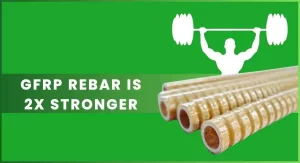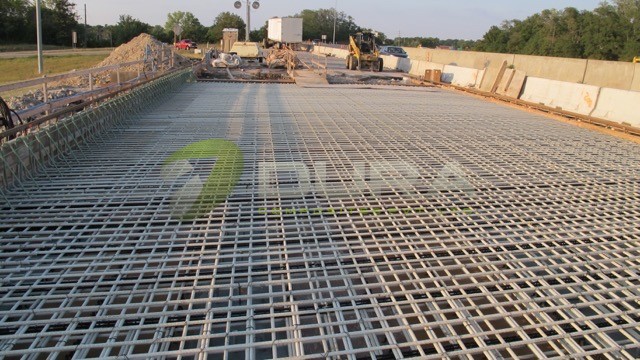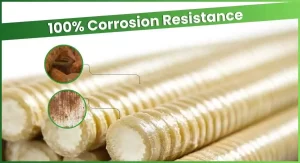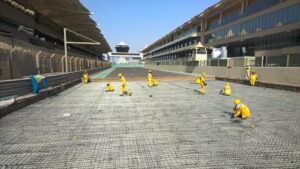In the realm of modern construction, sustainability and durability have become paramount. With increasing environmental concerns and the demand for longer-lasting infrastructure, the choice of materials plays a critical role in achieving these goals. GFRP (Glass Fiber Reinforced Polymer) rebar has emerged as a revolutionary solution, offering a unique combination of environmental benefits and unmatched durability. This post delves into why GFRP rebar is not just a sustainable choice but also a superior material for enhancing the longevity of structures.
The Imperative for Sustainable Building Practices
Sustainability in construction is no longer a trend but a necessity. As global climate challenges intensify, the construction industry is under pressure to reduce its carbon footprint and environmental impact. Traditional materials like steel, while robust, come with significant drawbacks, including high carbon emissions during production and vulnerability to environmental degradation. In this context, GFRP rebar presents a compelling alternative that aligns with sustainable building practices while offering enhanced durability.
Understanding GFRP Rebar: A New Benchmark in Concrete Reinforcement

GFRP rebar is a composite material made from glass fibers embedded in a polymer matrix. This composition gives GFRP rebar several distinct advantages over traditional steel, particularly in terms of durability and environmental impact.
One of the most significant benefits of GFRP rebar is its inherent resistance to corrosion. Unlike steel, which corrodes over time when exposed to moisture, chemicals, or salt, GFRP rebar is noncorrosive. This makes it an ideal choice for structures in harsh environments where exposure to corrosive elements is a concern. The result is a longer-lasting, more reliable reinforcement solution that minimizes the need for repairs and replacements.
Durability: The Cornerstone of Sustainable Construction

Durability is a key factor in sustainable construction. A durable structure not only conserves resources but also reduces the environmental impact associated with maintenance, repairs, and early replacements. GFRP rebar excels in this area, offering several durability properties that make it a superior choice for concrete reinforcement.
- Corrosion Resistance: A Lifespan Multiplier

The most well-known durability feature of GFRP rebar is its corrosion resistance. Steel rebar, when exposed to water, salts, and other chemicals, begins to rust, leading to expansion, cracking, and eventual weakening of the concrete. This is particularly problematic in environments such as coastal regions, areas with de-icing salts, or industrial sites where chemical exposure is common.
GFRP rebar, on the other hand, is immune to corrosion. Its noncorrosive nature ensures that it maintains its structural integrity over time, even in the most challenging environments. This not only extends the lifespan of the structure but also reduces the long-term costs associated with maintenance and repairs. In essence, GFRP rebar acts as a lifespan multiplier for concrete structures.
- High Tensile Strength: Withstanding the Test of Time
Another critical durability property of GFRP rebar is its high tensile strength. GFRP rebar offers tensile strength that is comparable to or even greater than steel, depending on the specific formulation. This high tensile strength allows it to withstand significant stress without deforming or failing, making it an excellent choice for reinforcing concrete in both standard and high-load applications.
This strength, combined with its lightweight nature, means that GFRP rebar can be used in a wide range of construction projects, from bridges and highways to high-rise buildings and marine structures. Its ability to maintain strength under pressure contributes to the overall durability and resilience of the structures it reinforces.
- Fatigue Resistance: Longevity Under Repeated Stress
Fatigue resistance refers to a material’s ability to withstand repeated cycles of stress without weakening or failing. This is an important factor in the durability of structures that experience dynamic loads, such as bridges, roads, and railways.
GFRP rebar exhibits excellent fatigue resistance, outperforming steel in situations where cyclical loading is a concern. This means that structures reinforced with GFRP rebar are better equipped to handle the stresses of daily use, from vehicle traffic on bridges to the constant motion of water against marine structures. Over time, this resistance to fatigue translates into longer-lasting infrastructure with fewer instances of structural failure.
- Chemical Resistance: Durability in Aggressive Environments
In addition to its corrosion resistance, GFRP rebar is also highly resistant to a wide range of chemicals. This makes it an ideal choice for environments where the concrete may be exposed to aggressive chemical agents, such as wastewater treatment plants, industrial facilities, and areas with high levels of soil acidity.
Chemical resistance ensures that the rebar will not degrade or weaken when exposed to these substances, maintaining the structural integrity of the concrete and extending the overall lifespan of the structure. This resistance is particularly valuable in applications where steel rebar would quickly deteriorate, leading to costly repairs and potential structural failures.
- Thermal Stability: Performance Across Temperature Extremes
Temperature fluctuations can have a significant impact on the durability of construction materials. GFRP rebar demonstrates excellent thermal stability, meaning it can perform well across a wide range of temperatures without losing its strength or integrity.
Whether in extreme cold or intense heat, GFRP rebar maintains its properties, making it suitable for a variety of climates and environments. This thermal stability further enhances the durability of structures reinforced with GFRP rebar, ensuring they remain robust and reliable over time, regardless of the external conditions.
Environmental Impact: Building with a Smaller Footprint

Beyond its durability, GFRP rebar also offers substantial environmental benefits that align with the goals of sustainable construction.
- Lower Carbon Emissions: A Greener Choice
The production of GFRP rebar involves significantly lower carbon emissions compared to steel. The energy-intensive processes required to produce steel, including mining, refining, and smelting, contribute heavily to global carbon emissions. In contrast, the manufacturing of GFRP rebar is less energy-intensive, resulting in a smaller carbon footprint.
By choosing GFRP rebar, builders can reduce the carbon emissions associated with their projects, contributing to the global effort to combat climate change. This makes GFRP rebar not only a durable choice but also a responsible one.
- Waste Reduction: Sustainable Lifecycle
The long lifespan of GFRP rebar means fewer replacements and less waste over the life of a structure. Traditional steel-reinforced structures often require significant repairs or replacements due to corrosion and other forms of degradation. These repairs generate waste and consume additional resources.
With GFRP rebar, the need for such interventions is drastically reduced, leading to a more sustainable lifecycle for the structure. This reduction in waste is a critical component of sustainable building practices, as it minimizes the environmental impact of the construction industry.
- Compatibility with Green Building Standards
GFRP rebar’s environmental and durability benefits make it an ideal candidate for projects seeking green building certifications, such as LEED (Leadership in Energy and Environmental Design). Its noncorrosive nature, combined with its low environmental impact, contributes to the sustainability criteria set by these standards, helping projects achieve certification and recognition for their commitment to environmental responsibility.
Conclusion: The Future of Construction with GFRP Rebar
As the construction industry moves toward more sustainable and durable building practices, GFRP rebar stands out as a material that meets the demands of the future. Its superior durability, resistance to environmental factors, and lower environmental impact make it an excellent choice for a wide range of construction projects.
For contractors, engineers, and builders, the choice is clear: adopting GFRP rebar is not just about enhancing the durability of your structures; it’s about contributing to a more sustainable, resilient, and responsible construction industry. By integrating GFRP rebar into your projects, you’re building not only for today but for generations to come—creating structures that stand the test of time while minimizing their impact on the planet.
